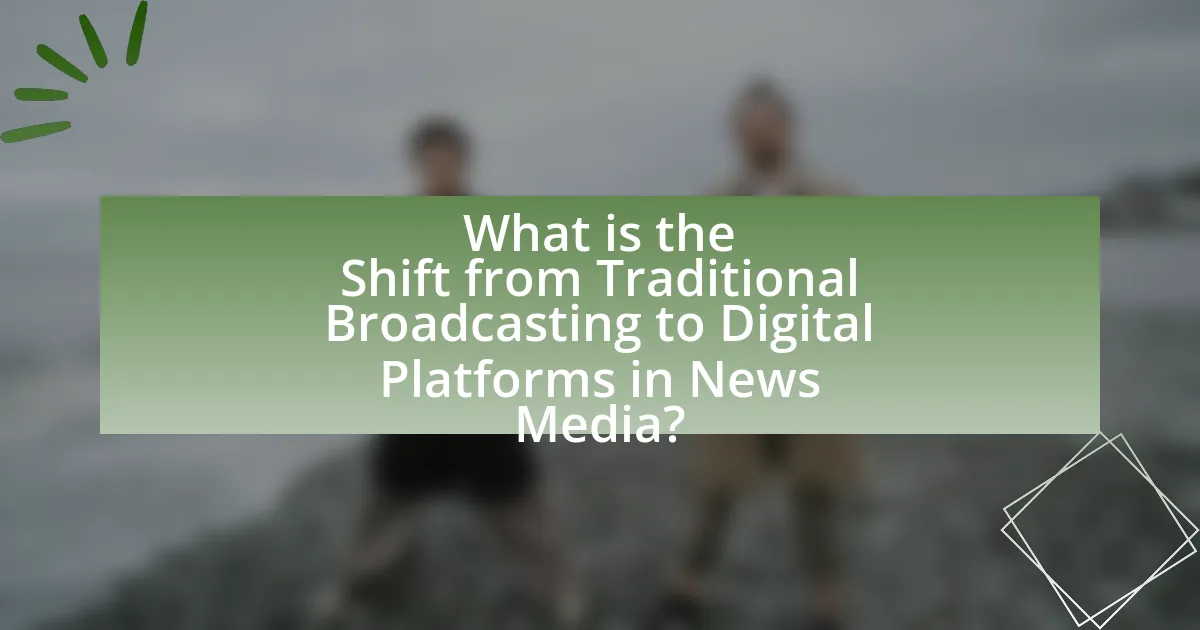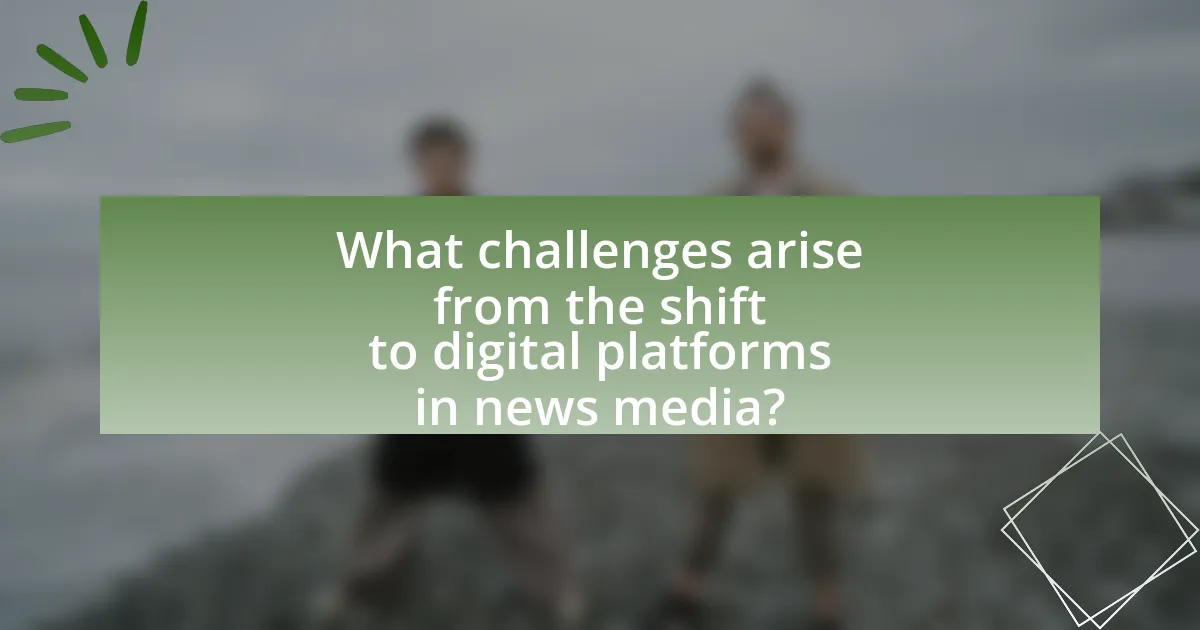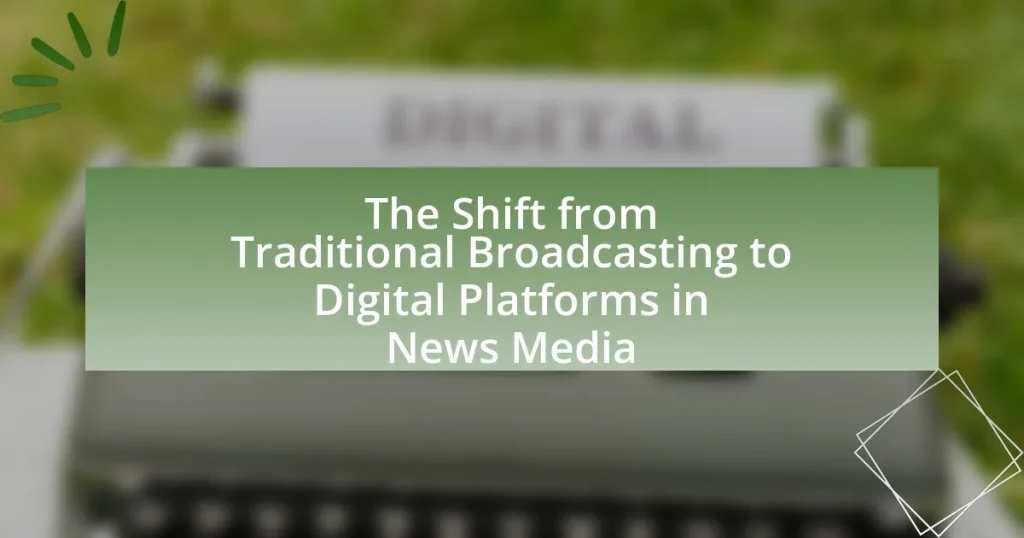The article examines the significant shift from traditional broadcasting to digital platforms in news media, highlighting how audiences increasingly prefer online news consumption over conventional television and radio. Key factors driving this transition include technological advancements, changing consumer behaviors, and economic pressures, which have led to new business models and altered the production and distribution of news. The article also discusses the implications of this shift on audience engagement, the credibility of news sources, and the challenges posed by misinformation and audience fragmentation in the digital landscape. Additionally, it outlines best practices for news organizations to adapt effectively to the evolving media environment.

What is the Shift from Traditional Broadcasting to Digital Platforms in News Media?
The shift from traditional broadcasting to digital platforms in news media refers to the transition where audiences increasingly consume news through online channels rather than through conventional television or radio. This change is driven by factors such as the rise of the internet, mobile technology, and social media, which provide immediate access to news content anytime and anywhere. According to a Pew Research Center study, as of 2021, 86% of Americans reported getting news from digital devices, highlighting a significant decline in traditional media consumption. This shift has led to the emergence of new business models, including subscription services and advertising on digital platforms, fundamentally altering how news is produced, distributed, and monetized.
How has the landscape of news media evolved over time?
The landscape of news media has evolved from traditional broadcasting to predominantly digital platforms. Historically, news was disseminated through print newspapers and television, which provided limited access and a one-way communication model. The advent of the internet in the late 20th century revolutionized this model, enabling real-time news updates and interactive engagement through websites and social media. By 2020, digital platforms accounted for over 60% of total news consumption in the United States, reflecting a significant shift in audience behavior and preferences. This transition has led to the rise of citizen journalism and the democratization of information, allowing diverse voices to contribute to the news landscape.
What are the key differences between traditional broadcasting and digital platforms?
Traditional broadcasting primarily relies on scheduled programming delivered through radio and television, while digital platforms offer on-demand content accessible via the internet. Traditional broadcasting operates within a fixed schedule and geographic limitations, whereas digital platforms provide global reach and flexibility, allowing users to consume content anytime and anywhere. For instance, according to the Pew Research Center, as of 2021, 86% of Americans reported using online platforms for news, highlighting the shift towards digital consumption. Additionally, traditional broadcasting typically has limited interactivity, while digital platforms enable user engagement through comments, shares, and personalized content recommendations.
How have audience preferences changed in relation to news consumption?
Audience preferences in news consumption have shifted significantly towards digital platforms over traditional broadcasting. This change is evidenced by a decline in television viewership and an increase in online news consumption, with a 2021 Pew Research Center study indicating that 86% of Americans get news from digital devices, compared to 61% from television. Additionally, younger demographics, particularly those aged 18-29, show a preference for social media as their primary news source, with 48% reporting they often get news from platforms like Facebook and Twitter. This trend reflects a broader move towards on-demand, personalized news experiences that digital platforms provide, contrasting with the scheduled programming of traditional media.
Why is the shift significant for the future of news media?
The shift from traditional broadcasting to digital platforms is significant for the future of news media because it fundamentally alters how information is disseminated and consumed. Digital platforms enable real-time news delivery, allowing audiences to access information instantly, which contrasts sharply with the delayed nature of traditional broadcasting. According to a Pew Research Center study, 86% of Americans get their news from digital devices, highlighting the growing preference for online news consumption. This transition not only increases accessibility but also fosters greater audience engagement through interactive content and social media integration, reshaping the relationship between news organizations and their audiences.
What impact does digital media have on news accessibility?
Digital media significantly enhances news accessibility by allowing users to access information anytime and anywhere through various devices. This shift from traditional broadcasting to digital platforms has democratized information dissemination, enabling a broader audience to engage with news content. According to a Pew Research Center study, as of 2021, 86% of Americans reported getting news from digital devices, illustrating the widespread adoption of digital media for news consumption. Furthermore, digital platforms often provide real-time updates and diverse perspectives, which traditional media struggled to offer, thus improving the overall accessibility and immediacy of news.
How does the shift influence the credibility of news sources?
The shift from traditional broadcasting to digital platforms significantly influences the credibility of news sources by altering how information is disseminated and consumed. Digital platforms enable rapid news distribution, which can lead to the spread of misinformation if not properly vetted. According to a 2020 study by the Pew Research Center, 55% of Americans reported encountering made-up news, highlighting the challenges digital platforms pose to credibility. Furthermore, the ease of access to diverse viewpoints can enhance credibility for some sources while undermining it for others, as audiences may struggle to discern reliable information amidst a plethora of opinions.

What are the driving forces behind the shift to digital platforms?
The driving forces behind the shift to digital platforms in news media include technological advancements, changing consumer behavior, and economic pressures. Technological advancements, such as the proliferation of smartphones and high-speed internet, have made digital content more accessible and convenient for users. Changing consumer behavior reflects a preference for on-demand content and personalized news experiences, with studies indicating that over 70% of people prefer consuming news online rather than through traditional media. Economic pressures, including declining advertising revenues for print media, have compelled news organizations to adopt digital strategies to remain financially viable. These factors collectively drive the transition from traditional broadcasting to digital platforms in the news media landscape.
How has technology contributed to this transformation?
Technology has significantly contributed to the transformation from traditional broadcasting to digital platforms in news media by enabling instant access to information and facilitating diverse content delivery. The advent of the internet and mobile devices has allowed news organizations to reach audiences in real-time, breaking geographical barriers that traditional broadcasting faced. For instance, according to a Pew Research Center report, as of 2021, 86% of Americans get their news from digital devices, highlighting a shift in consumer behavior towards online platforms. Additionally, social media platforms have become vital for news dissemination, allowing users to share and engage with content, further amplifying reach and interaction. This shift has fundamentally altered how news is produced, consumed, and monetized, emphasizing the role of technology in reshaping the media landscape.
What role do social media platforms play in news dissemination?
Social media platforms serve as crucial channels for news dissemination by enabling rapid sharing and access to information. These platforms facilitate real-time updates, allowing users to receive news as events unfold, which contrasts with the slower pace of traditional media. According to a Pew Research Center study, 53% of U.S. adults report that they often get news from social media, highlighting its significant role in shaping public awareness and discourse. Furthermore, social media algorithms prioritize content based on user engagement, which can amplify certain news stories while potentially sidelining others, thus influencing the public’s perception of newsworthiness.
How have mobile devices changed news consumption habits?
Mobile devices have significantly transformed news consumption habits by enabling instant access to information anytime and anywhere. This shift has led to a preference for real-time updates, with studies indicating that 86% of Americans get news on their mobile devices, according to the Pew Research Center. Furthermore, mobile devices facilitate personalized news experiences through apps and notifications, allowing users to curate content that aligns with their interests. As a result, traditional news outlets have adapted their strategies to prioritize mobile-friendly formats, reflecting the growing trend of on-the-go news consumption.
What economic factors are influencing this shift?
The economic factors influencing the shift from traditional broadcasting to digital platforms in news media include declining advertising revenues for traditional outlets, the rise of digital advertising, and changing consumer spending habits. Traditional broadcasters have experienced a significant drop in ad revenue, with a 2020 report indicating that U.S. television ad spending fell by 11% due to shifts in viewer behavior and the pandemic. In contrast, digital advertising has surged, with eMarketer projecting that digital ad spending will surpass traditional ad spending by 2023, driven by the increasing preference for online content consumption. Additionally, consumers are reallocating their spending towards subscription-based digital services, as evidenced by a 2021 survey showing that 70% of consumers prefer to pay for digital news subscriptions over traditional cable packages. These economic dynamics are reshaping the media landscape, pushing news organizations to adapt to digital platforms to remain financially viable.
How has advertising revenue changed with the rise of digital platforms?
Advertising revenue has significantly shifted from traditional media to digital platforms due to the increasing consumption of online content. In 2021, digital advertising revenue in the United States reached approximately $200 billion, surpassing traditional advertising revenue for the first time, which was around $150 billion. This transition is driven by factors such as targeted advertising capabilities, real-time analytics, and the growing use of mobile devices, which have made digital platforms more appealing to advertisers. As a result, companies are reallocating their budgets to capitalize on the effectiveness and reach of digital advertising compared to traditional methods.
What are the financial implications for traditional news organizations?
Traditional news organizations face significant financial implications due to the shift from traditional broadcasting to digital platforms. This transition has led to declining advertising revenues, as advertisers increasingly allocate budgets to digital channels, resulting in a 41% drop in print advertising revenue from 2006 to 2020, according to the Pew Research Center. Additionally, traditional news organizations are experiencing increased operational costs associated with maintaining legacy systems while investing in digital infrastructure. The combination of reduced revenue streams and rising costs has forced many organizations to downsize, leading to layoffs and reduced news coverage, which further impacts their financial viability.

What challenges arise from the shift to digital platforms in news media?
The shift to digital platforms in news media presents several challenges, including revenue loss, misinformation, and audience fragmentation. Traditional advertising revenue has declined significantly, with digital ad spending surpassing print but often yielding lower returns for publishers. According to the Pew Research Center, U.S. newspaper advertising revenue fell from $49.4 billion in 2005 to $14.3 billion in 2020, highlighting the financial strain on news organizations.
Misinformation has proliferated on digital platforms, as the ease of sharing content allows false narratives to spread rapidly, undermining public trust in journalism. A study by the Massachusetts Institute of Technology found that false news stories are 70% more likely to be retweeted than true stories, illustrating the challenge of maintaining credibility in a digital landscape.
Audience fragmentation occurs as consumers access news from various sources, leading to a decline in shared public discourse. The Reuters Institute for the Study of Journalism reported that 61% of people in the U.S. use social media for news, which often results in echo chambers and reduced exposure to diverse viewpoints. These challenges collectively threaten the sustainability and integrity of news media in the digital age.
How does misinformation affect the digital news landscape?
Misinformation significantly undermines the credibility and reliability of the digital news landscape. It leads to the spread of false narratives, which can distort public perception and influence societal behavior. For instance, a study by the Pew Research Center found that 64% of Americans believe that fabricated news stories cause confusion about the basic facts of current events. This proliferation of misinformation not only erodes trust in legitimate news sources but also creates an environment where users struggle to discern credible information from falsehoods, ultimately impacting informed decision-making and public discourse.
What strategies can be employed to combat fake news?
To combat fake news, strategies such as media literacy education, fact-checking initiatives, and the use of technology to identify misinformation can be employed. Media literacy education equips individuals with the skills to critically evaluate sources and discern credible information from falsehoods. Fact-checking initiatives, like those conducted by organizations such as Snopes and FactCheck.org, provide verified information to counter false claims. Additionally, technology, including algorithms and artificial intelligence, can help detect and flag misleading content on social media platforms, as evidenced by Facebook’s efforts to reduce the spread of misinformation through third-party fact-checkers. These strategies collectively enhance public awareness and reduce the impact of fake news.
How do algorithms influence the news that audiences receive?
Algorithms significantly influence the news that audiences receive by determining which stories are prioritized and presented based on user engagement metrics. These algorithms analyze user behavior, such as clicks, shares, and time spent on articles, to curate personalized news feeds that align with individual preferences. For instance, a study by the Pew Research Center found that 62% of Americans get their news from social media, where algorithms play a crucial role in shaping visibility and reach. This means that the news audiences encounter is often tailored to reinforce existing beliefs, potentially leading to echo chambers and reduced exposure to diverse viewpoints.
What are the implications for journalism ethics in the digital age?
The implications for journalism ethics in the digital age include challenges related to misinformation, transparency, and accountability. Digital platforms enable rapid dissemination of information, which can lead to the spread of false narratives, as evidenced by the proliferation of fake news during events like the 2016 U.S. presidential election. Journalists must navigate the ethical responsibility of verifying sources and ensuring accuracy in a landscape where information can be manipulated easily. Additionally, the rise of algorithms that prioritize engagement over factual reporting raises concerns about the ethical implications of prioritizing sensationalism over truth. The need for transparency in sourcing and funding is also heightened, as audiences demand clarity regarding the origins of news content. These factors collectively underscore the necessity for a reevaluation of ethical standards in journalism to maintain credibility and public trust in the digital era.
How can journalists maintain integrity in a fast-paced digital environment?
Journalists can maintain integrity in a fast-paced digital environment by adhering to rigorous fact-checking protocols and prioritizing transparency in their reporting. This commitment to accuracy ensures that information disseminated to the public is reliable, which is crucial given the rapid spread of misinformation online. According to a 2021 study by the Pew Research Center, 64% of Americans believe that misinformation is a major problem in the news, highlighting the need for journalists to uphold high standards of truthfulness. Additionally, establishing clear editorial guidelines and fostering a culture of accountability within news organizations can further reinforce journalistic integrity in the digital landscape.
What ethical dilemmas arise from the use of digital platforms?
The ethical dilemmas arising from the use of digital platforms include issues of privacy, misinformation, and algorithmic bias. Privacy concerns stem from the collection and use of personal data by platforms, often without explicit consent, leading to potential exploitation of user information. Misinformation is prevalent as digital platforms can rapidly disseminate false information, impacting public opinion and trust in media. Algorithmic bias occurs when the algorithms that curate content reflect societal biases, potentially marginalizing certain groups and skewing public discourse. These dilemmas highlight the need for ethical guidelines and accountability in the digital media landscape.
What best practices can news organizations adopt in the digital era?
News organizations can adopt several best practices in the digital era, including prioritizing audience engagement, utilizing data analytics, and ensuring content accessibility. Prioritizing audience engagement involves actively interacting with readers through social media and comment sections, which fosters community and loyalty. Utilizing data analytics allows news organizations to understand audience preferences and tailor content accordingly, enhancing relevance and reach. Ensuring content accessibility means providing information in various formats, such as text, video, and audio, to cater to diverse audience needs and preferences. These practices are supported by studies showing that engaged audiences are more likely to consume and share news, while data-driven strategies can increase readership and retention rates.
How can traditional broadcasters effectively transition to digital platforms?
Traditional broadcasters can effectively transition to digital platforms by adopting a multi-faceted strategy that includes investing in technology, developing digital content, and engaging with audiences through social media. This approach allows broadcasters to reach a wider audience and adapt to changing consumer behaviors. For instance, according to a 2021 report by the Pew Research Center, 86% of Americans get news from digital devices, highlighting the necessity for broadcasters to establish a strong online presence. Additionally, integrating data analytics can help broadcasters understand viewer preferences and tailor content accordingly, further enhancing audience engagement and retention.
What role does audience engagement play in successful digital news strategies?
Audience engagement is crucial for successful digital news strategies as it directly influences content reach, retention, and audience loyalty. Engaged audiences are more likely to share content, participate in discussions, and return for future updates, which enhances the visibility and credibility of news outlets. According to a 2021 study by the Pew Research Center, 53% of adults in the U.S. reported that they often get news from social media, highlighting the importance of engagement in driving traffic to digital platforms. Furthermore, high levels of audience interaction can lead to better insights into audience preferences, allowing news organizations to tailor their content effectively, thereby increasing overall engagement and satisfaction.




